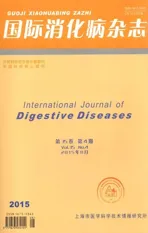结直肠癌早期诊断的分子生物学研究进展
2015-03-20张观坡李兆申
张观坡 柏 愚 李兆申
结直肠癌(CRC)是全球第三位高发的癌症,同时也是癌症致死的第四大病因[1]。早期发现、早期治疗是减少CRC发病率和病死率的有效手段。结肠镜检查是目前筛查CRC的金标准,美国50岁以上人群的结肠镜筛查率只有29.8%~55.2%[2],中国适龄人群的结肠镜受检率也偏低[3]。此外,结肠镜检查存在一定的漏检率,如结肠腺瘤的漏检率可达6%~12%,而CRC的漏检率亦可达5%[4]。因此,为了提高适龄人群尤其是CRC高危患者的筛查率,迫切需要新的筛查手段,如寻找血液或粪便中CRC的肿瘤标志物。随着分子生物学以及新一代测序技术的发展,研究者从患者血液及粪便中发现了越来越多的肿瘤标志物,其中具有较高敏感度和特异度的DNA和RNA具有广阔的应用前景。
1 DNA
血中游离DNA简称循环核酸,是指循环血中游离于细胞外部分的已降解的机体内源性DNA,可以来源于肿瘤细胞的坏死、凋亡或直接分泌[5]。循环核酸一般只有70~200 bp[6],在血液中的含量极其微少使得分离极其困难,但随着测序技术的不断进步,目前已可以高度敏感及特异地检测血液中微量的循环核酸,从而为寻求新的早期无创筛查CRC的标志物提供了可能[7]。
1.1 异常DNA甲基化
DNA甲基化对细胞的正常分化和胚胎的发育极其重要,但是异常的DNA甲基化却与肿瘤的发生发展密切相关。早在1983年,Feinberg等[8]就报道了DNA异常甲基化和肿瘤发生的关系。DNA甲基化可以沉默基因的表达,如抑癌基因启动子CpG岛的高甲基化可以引起DNA双链更紧密地折叠而影响转录,从而导致癌症[9-10]。很多研究发现,DNA甲基化与肿瘤发生的早期事件相关,因而其被认为是一个潜在的早期肿瘤检测指标[11-12]。
目前,仅有少数几个DNA甲基化的标志物实现商业化。如ColoVantage○R是一种基于检测血浆中SEPT9基因甲基化的试剂盒,其对CRC的总体敏感度达90%,其中对1期和2期CRC的敏感度为87%,对3期和4期CRC的敏感度达100%[13]。Epi proColon○R2.0亦是一种基于检测血浆中SEPT9基因甲基化的试剂盒,其对CRC的总体敏感度达95.6%,其中对1期CRC的敏感度为84%,对2~4期CRC的敏感度亦达100%;使用此试剂盒时,其在左半结肠的阳性率达96.4%,在右半结肠的阳性率达94.4%[14]。ColoSureTM则是一种基于检测粪便中vimentin基因甲基化的试剂盒,其对CRC的敏感度为38%~88%,该试剂盒被推荐与结肠镜检查联合筛查CRC[15]。
不过大部分DNA甲基化的生物标志物尚处于科研及临床试验阶段。在21世纪初,Nakayama等[16]和 Lecomte等[17]检测到,肿瘤抑制基因 p16的启动子高甲基化在CRC患者血液中的阳性率分别为68%和69%。而Grady等[18]检测到hMLH1启动子异常甲基化在CRC患者血清中的阳性率仅为47%。Oh等[19]研究发现,异常SDC2甲基化在139例Ⅰ~Ⅳ期CRC患者肿瘤组织中的表达率为97.8%,而血清中SDC2甲基化的敏感度为87.0%,特异度为95.2%,特别是在Ⅰ期CRC患者的敏感度可高达92.3%,使其可以作为潜在的早期检测CRC的标志物。而对于粪便来源的DNA,由于各研究对标本处理的方法存在更大的异质性,使得目前研究结果并不令人满意。如 Glöckner等[20]发现,TFPI2的异常甲基化在CRC腺瘤的检出率为97%,在Ⅰ~Ⅳ期CRC患者肿瘤组织中更高达99%;而其在Ⅰ~Ⅲ期CRC患者的粪便标本中敏感度为76%~89%,特异度为79%~93%。其他学者在CRC患者粪便中检测到的NDRG4启动子及转录因子GATA4等基因的异常甲基化虽然敏感度仅为51%~53%,但特异度可达93%~100%。即便如此,这些研究仍需扩大样本以进一步验证。
鉴于检测单个基因的局限性,许多学者采用联合检测多基因甲基化的策略以提高敏感度和特异度。Lind等[21]联合检测血清中 CNIP1、FBN1、INA、SNCA、MAL和SPG20,发现≥2个以上上述基因的启动子出现高甲基化,其敏感度在腺瘤和CRC中分别为93%和94%,特异度可达98%。Alhquist等[22]则联合检测了粪便中骨形成蛋白3(BMP3)、NDRG4、vimenti、TFPI2、突变型 KRAS、β-肌动蛋白(β-actin)等基因的甲基化,其对CRC的敏感度可达87%。相信随着研究的进展,将来一定会出现更多的优化组合标志物,可进一步提高CRC早期检测的敏感度和特异度。
1.2 异常的肿瘤DNA突变
在结直肠正常上皮细胞由腺瘤向腺癌的发生过程中,突变的基因如KRAS、p53、APC可以在血循环中被检测到[17,23-24],但与野生型 DNA 相比,含量非常低[25]。例如,Diehl等[24]研 究 发现,59% 的CRC患者(n=56)血浆中可以检测到突变的APC,但其中晚期CRC患者的血浆中突变的APC基因仅占总APC基因的1.9%~27%,而早期CRC患者则仅有0.01%~0.12%。即便使用直接测序技术,在野生型DNA的背景中,其突变信号的检出率也低于25%[26]。因此,目前的技术尚难以开发低成本且具高敏感度的方法用来检测所有体细胞突变,作为早期检测CRC的指标。
1.3 微卫星改变
微卫星不稳定性(MSI)是指与正常组织相比,在肿瘤中某一微卫星由于重复单位的插入或缺失而造成的微卫星长度的任何改变,出现新的微卫星等位基因现象。杂合性是指在同源染色体上的一个或多个位点上有不同等位基因存在的状态。微卫星改变包括MSI和失去杂合性,与肿瘤的发生、进展相关,因而被认为可作为潜在的肿瘤检测指标[27]。Hibi等[28]研究发现,80%的原发性 CRC 中存在MSI或失去杂合性的改变,但无1例出现在相应患者的血清DNA中。总体上,在检测早期CRC时,微卫星改变表现出较低的敏感度和特异度,目前尚难以作为早期检测CRC的指标。
1.4 循环线粒体DNA
在每个细胞中均有数以百计的线粒体DNA拷贝,而正是由于其多拷贝的特性,线粒体DNA通常表现出异质性。对肿瘤细胞而言,除了表现出与特定肿瘤相关的异质性之外,还存在D-襻区域的变异[29]。Hibi等[30]研究发现,在早期 CRC中,近9%(7/77)的CRC组织存在线粒体DNA的改变,但在这7例患者中,仅有1例的血清中存在线粒体DNA的改变。鉴于线粒体DNA在早期CRC中极低的阳性率,更多的研究将重点放在其与CRC晚期转移的关系上。
2 RNA
通常认为RNA是一种高度不稳定、容易降解的小分子物质,但随着研究的深入,许多研究证实RNA可以稳定的存在于外周血中,这可能与其在血液中与蛋白质或磷脂相结合,从而可以抵御RNA酶降解有关[31]。这些RNA包括编码RNA[如信使RNA(mRNA)]及非编码 RNA[如微小 RNA(microRNA)和长链非编码 RNA(lncRNA)][32-33]。不仅如此,这些RNA还可以在血浆或血清中被抽提及检测出来[34-35]作为潜在的肿瘤标志物[36]。
2.1 mRNA
mRNA是由DNA的一条链作为模板转录而来的、携带遗传信息的能指导蛋白合成的一类单链核糖核酸。mRNA的研究策略是通过分析mRNA芯片特征继而使用RT-PCR进行确证。
Tsouma等[37]通过提取CRC患者的外周血RNA并使用多重RT-PCR技术分析癌胚抗原(CEA)、细胞角蛋白20(CK20)、表皮生长因子受体(EGFR)mRNA的改变,发现其阳性率分别为95.5%、78.4%和19.3%,并且其与疾病分期及术前CEA水平呈正相关。但目前关于mRNA和CRC的研究资料不多,可能与芯片技术逐渐被新一代测序技术取代有关。
2.2 microRNA
microRNA是一类进化上保守的非编码单链小RNA分子,长度约为18~25个核苷酸,其最早是由Lee等[38]于1993年在秀丽新小杆线虫中发现的。microRNA通过与其靶mRNA上的互补序列的碱基配对,进而引起转录抑制或mRNA降解[39]。可以由一个microRNA调控多个目的基因的表达,也可以由几个microRNA调节同一个基因的表达[40]。异常的microRNA表达可以作为早期肿瘤的诊断标志物。
Michael等[41]于2003年最先分析了28种microRNA在人CRC组织与正常黏膜组织中的差异表达,发现miR-143和miR-145具有显著差异。而Ng等[42]于2009年首次使用实时PCR技术筛选了CRC患者血浆中95种microRNA的变化,其中miR-17-3p和miR-92显著升高,其敏感度为89%、特异度为70%。至今为止,有多达数十种血浆中的microRNA被提出来作为CRC的肿瘤标志物,其敏感度为68%~91%、特异度为41%~95%。在这些microRNA中,原癌基因性microRNA如miR-17、miR-21、miR-31、miR-92a、miR-106a、miR-106b、miR-135a、miR-135b和 miR-155的表达上调与CRC相关,而抑癌基因性microRNA如miR-143、miR-145 miR-148a、miR-148b和miR-215的表达下调亦与CRC相关。另一方面,在CRC血循环中表达上调的 miR-15b、miR-17-5p、miR-18a、miR-142-3p、miR-195、miR-331、miR-532-5p、miR-532-3p、miR-652以及表达下调的miR-601、miR-760被认为可以鉴别进展期腺瘤和CRC,并且miR-15b、miR-17-3p、miR-18a、miR-20a、miR-21、miR-29a和miR-92a都已被超过一个研究小组报道过。尽管如此,仍有相当多的研究结果未被其他研究者所重复,如Faltejskova等[43]的研究并没有证实miR-17-3p、miR-29a、miR-92a、和 miR-135b可作为CRC的肿瘤标志物。这些不一致的研究结果可能是由于实验设计、患者来源以及实验条件不同引起的。因此,将来需要确立标准的实验控制条件后进行更大范围的多中心研究,才可能确定哪些microRNA可以作为CRC肿瘤标志物。
2.3 lncRNA
lncRNA为长度超过200 nt的RNA分子,其不直接编码蛋白,而是以RNA的形式在多个层面上调控基因的表达水平。lncRNA最初被认为是“垃圾RNA”,但随着研究的深入,lncRNA成为近年来生命科学研究的前沿和热点,其对基因的调节及细胞的功能发挥着极其重要的作用[44],尤其是在肿瘤抑制及生成中的作用,因此lncRNA作为癌症潜在的肿瘤标志物也越来越受到重视[45]。
目前仅有的研究都是以CRC组织作为标本。如Ge等[46]研究发现,前列腺癌相关lncRNA转录因子1在CRC组织中上调,但附近的正常组织为阴性表达。Zhai等[47]研究发现,长的基因间非编码RNA-p21在CRC组织中表达上调,并且与肿瘤进展相关。Ling等[48]发现lncRNA-CCAT2在CRC组织中高度表达,并且可以促进肿瘤生长、转移和染色 体 的 不 稳 定。Kogo 等[49]发 现 lncRNAHOTAIR的表达在晚期CRC的组织中表达较高。Xu等[50]则发现lncRNA-人肺腺癌转移相关转录因子1(MALAT-1)在CRC组织中表达下调。鉴于lncRNA在基因调控中的重要作用以及随着下一代测序技术的进步及普及,将来会有更多的血循环lncRNA和CRC相关研究出现。
3 结语
早期筛查CRC是减少CRC发病率及病死率的最有效手段。虽然目前最有效的筛查方法仍是结肠镜检查,但考虑到其较低的受检率,迫切需要新的筛查手段,其必须满足价格低廉、低风险、高敏感度并且不需要繁琐的肠道准备等优点,才可以提高公众尤其是高风险人群进行CRC筛查的意愿。通过分析患者血液或粪便中DNA或RNA的变化,可以有效寻找到高敏感度及特异度的早期CRC肿瘤标志物。虽然在目前的研究中,这些肿瘤标志物尚难以广泛应用于临床,但随着下一代测序技术的进步及普及,相信可以寻找到更加特异的早期CRC肿瘤标志物。
1 Ferlay J,Shin HR,Bray F,et al.Estimates of worldwide burden of cancer in 2008:GLOBOCAN2008.Int J Cancer,2010,127:2893-2917.
2 Beydoun HA,Beydoun MA.Predictors of colorectal cancer screening behaviors among average-risk older adults in the United States.Cancer Causes Control,2008,19:339-359.
3 Deng SX,Gao J,An W,et al.Colorectal cancer screening behavior and willingness:an outpatient survey in China.World J Gastroenterol,2011,17:3133-3139.
4 Levin TR,Corley DA.Colorectal-cancer screening--coming of age.N Engl J Med,2013,369:1164-1166.
5 Schwarzenbach H,Hoon DS,Pantel K.Cell-free nucleic acids as biomarkers in cancer patients.Nat Rev Cancer,2011,11:426-437.
6 Jahr S,Hentze H,Englisch S,et al.DNA fragments in the blood plasma of cancer patients:quantitations and evidence for their origin from apoptotic and necrotic cells.Cancer Res,2001,61:1659-1665.
7 Kaiser J.Medicine.Keeping tabs on tumor DNA.Science,2010,327:1074.
8 Feinberg AP,Vogelstein B.Hypomethylation distinguishes genes of some human cancers from their normal counterparts.Nature,1983,301:89-92.
9 Laird PW,Jaenisch R.DNA methylation and cancer.Hum Mol Genet,1994,3:1487-1495.
10 Jones PA,Baylin SB.The fundamental role of epigenetic events in cancer.Nat Rev Genet,2002,3:415-428.
11 Sandoval J,Esteller M.Cancer epigenomics:beyond genomics.Curr Opin Genet Dev,2012,22:50-55.
12 Gyparaki MT, Basdra EK, Papavassiliou AG. DNA methylation biomarkers as diagnostic and prognostic tools in colorectal cancer.J Mol Med(Berl),2013,91:1249-1256.
13 Warren JD,Xiong W,Bunker AM,et al.Septin 9 methylated DNA is a sensitive and specific blood test for colorectal cancer.BMC Med,2011,9:133.
14 Toth K,Sipos F,Kalmar A,et al.Detection of methylated SEPT9in plasma is a reliable screening method for both left-and right-sided colon cancers.PLoS One,2012,7:e46000.
15 Ned RM,Melillo S,Marrone M.Fecal DNA testing for Colorectal Cancer Screening:the ColoSureTM test.PLoS Curr,2011,3:RRN1220.
16 Nakayama H,Hibi K,Takase T,et al.Molecular detection of p16 promoter methylation in the serum of recurrent colorectal cancer patients.Int J Cancer,2003,105:491-493.
17 Lecomte T,Berger A,Zinzindohoue F,et al.Detection of freecirculating tumor-associated DNA in plasma of colorectal cancer patients and its association with prognosis.Int J Cancer,2002,100:542-548.
18 Grady WM,Rajput A,Lutterbaugh JD,et al.Detection of aberrantly methylated hMLH1 promoter DNA in the serum of patients with microsatellite unstable colon cancer.Cancer Res,2001,61:900-902.
19 Oh T,Kim N,Moon Y,et al.Genome-wide identification and validation of a novel methylation biomarker,SDC2,for bloodbased detection of colorectal cancer.J Mol Diagn,2013,15:498-507.
20 Glöckner SC,Dhir M,Yi JM,et al.Methylation of TFPI2 in stool DNA:apotential novel biomarker for the detection of colorectal cancer.Cancer Res,2009,69:4691-4699.
21 Lind GE,Danielsen SA,Ahlquist T,et al.Identification of an epigenetic biomarker panel with high sensitivity and specificity for colorectal cancer and adenomas.Mol Cancer,2011,10:85.22 Ahlquist DA,Taylor WR,Mahoney DW,et al.The stool DNA test is more accurate than the plasma septin 9 test in detecting colorectal neoplasia.Clin Gastroenterol Hepatol,2012,10:272-277.
23 Szymanska K,Lesi OA,Kirk GD,et al.Ser-249TP53 mutation in tumour and plasma DNA of hepatocellular carcinoma patients from a high incidence area in the Gambia,West Africa.Int J Cancer,2004,110:374-379.
24 Diehl F,Li M,Dressman D,et al.Detection and quantification of mutations in the plasma of patients with colorectal tumors.Proc Natl Acad Sci U S A,2005,102:16368-16373.
25 Diehl F,Schmidt K,Choti MA,et al.Circulating mutant DNA to assess tumor dynamics.Nat Med,2008,14:985-990.
26 Gormally E,Caboux E,Vineis P,et al.Circulating free DNA in plasma or serum as biomarker of carcinogenesis:practical aspects and biological significance.Mutat Res,2007,635:105-117.
27 Chen XQ,Stroun M,Magnenat JL,et al.Microsatellite alterations in plasma DNA of small cell lung cancer patients.Nat Med,1996,2:1033-1035.
28 Hibi K,Robinson CR,Booker S,et al.Molecular detection of genetic alterations in the serum of colorectal cancer patients.Cancer Res,1998,58:1405-1407.
29 Kuo SJ,Chen M,Ma GC,et al.Number of somatic mutations in the mitochondrial D-loop region indicates poor prognosis in breast cancer,independent of TP53 mutation.Cancer Genet Cytogenet,2010,201:94-101.
30 Hibi K,Nakayama H,Yamazaki T,et al.Detection of mitochondrial DNA alterations in primary tumors and corresponding serum of colorectal cancer patients.Int J Cancer,2001,94:429-431.
31 Hasselmann DO,Rappl G,Tilgen W,et al.Extracellular tyrosinase mRNA within apoptotic bodies is protected from degradation in human serum.Clin Chem,2001,47:1488-1489.
32 Kopreski MS,Benko FA,Kwak LW,et al.Detection of tumor messenger RNA in the serum of patients with malignant melanoma.Clin Cancer Res,1999,5:1961-1965.
33 Cortez MA,Bueso-Ramos C,Ferdin J,et al.MicroRNAs in body fluids--the mix of hormones and biomarkers.Nat Rev Clin Oncol,2011,8:467-477.
34 Sourvinou IS,Markou A,Lianidou ES.Quantification of circulating miRNAs in plasma:effect of preanalytical and analytical parameters on their isolation and stability.J Mol Diagn,2013,15:827-834.
35 Mitchell PS,Parkin RK,Kroh EM,et al.Circulating microRNAs as stable blood-based markers for cancer detection.Proc Natl Acad Sci U S A,2008,105:10513-10518.
36 Shen J,Stass SA,Jiang F.MicroRNAs as potential biomarkers in human solid tumors.Cancer Lett,2013,329:125-136.
37 Tsouma A,Aggeli C,Lembessis P,et al.Multiplex RT-PCR-based detections of CEA,CK20 and EGFR in colorectal cancer patients.World J Gastroenterol,2010,16:5965-5974.
38 Lee RC, Feinbaum RL, Ambros V. The C.elegans heterochronic gene lin-4 encodes small RNAs with antisense complementarity to lin-14.Cell,1993,75:843-854.
39 O′Hara SP,Mott JL,Splinter PL,et al.MicroRNAs:key modulators of posttranscriptional gene expression.Gastroenterology,2009,136:17-25.
40 Sayed D,Abdellatif M.MicroRNAs in development and disease.Physiol Rev,2011,91:827-887.
41 Michael MZ,O′Connor SM,van Holst Pellekaan NG,et al.Reduced accumulation of specific microRNAs in colorectal neoplasia.Mol Cancer Res,2003,1:882-891.
42 Ng EK,Chong WW,Jin H,et al.Differential expression of microRNAs in plasma of patients with colorectal cancer:a potential marker for colorectal cancer screening.Gut,2009,58:1375-1381.
43 Faltejskova P,Bocanek O,Sachlova M,et al.Circulating miR-17-3p,miR-29a,miR-92a and miR-135b in serum:Evidence against their usage as biomarkers in colorectal cancer.Cancer Biomark,2012,12:199-204.
44 Atkinson SR,Marguerat S,Bahler J.Exploring long noncoding RNAs through sequencing.Semin Cell Dev Biol,2012,23:200-205.
45 Shi X,Sun M,Liu H,et al.Long non-coding RNAs:a new frontier in the study of human diseases.Cancer Lett,2013,339:159-166.
46 Ge X,Chen Y,Liao X,et al.Overexpression of long noncoding RNA PCAT-1is a novel biomarker of poor prognosis in patients with colorectal cancer.Med Oncol,2013,30:588.
47 Zhai H,Fesler A,Schee K,et al.Clinical significance of long intergenic noncoding RNA-p21 in colorectal cancer.Clin Colorectal Cancer,2013,12:261-266.
48 Ling H,Spizzo R,Atlasi Y,et al.CCAT2,a novel noncoding RNA mapping to 8q24,underlies metastatic progression and chromosomal instability in colon cancer.Genome Res,2013,23:1446-1461.
49 Kogo R,Shimamura T,Mimori K,et al.Long noncoding RNA HOTAIR regulates polycomb-dependent chromatin modification and is associated with poor prognosis in colorectal cancers.Cancer Res,2011,71:6320-6326.
50 Xu C,Yang M,Tian J,et al.MALAT-1:a long non-coding RNA and its important 3′end functional motif in colorectal cancer metastasis.Int J Oncol,2011,39:169-175.
